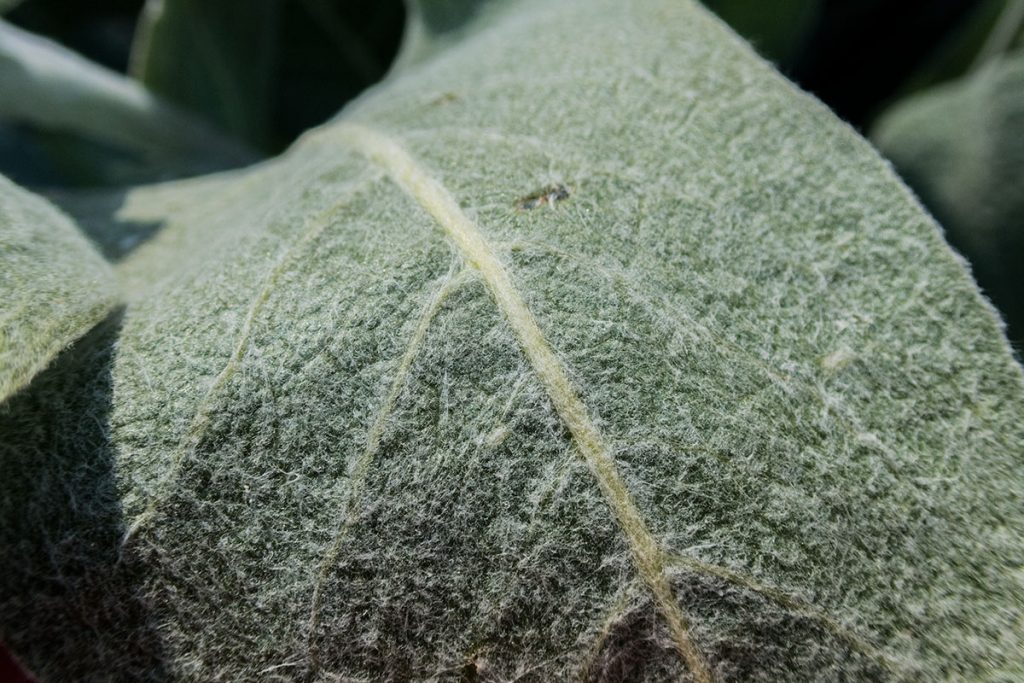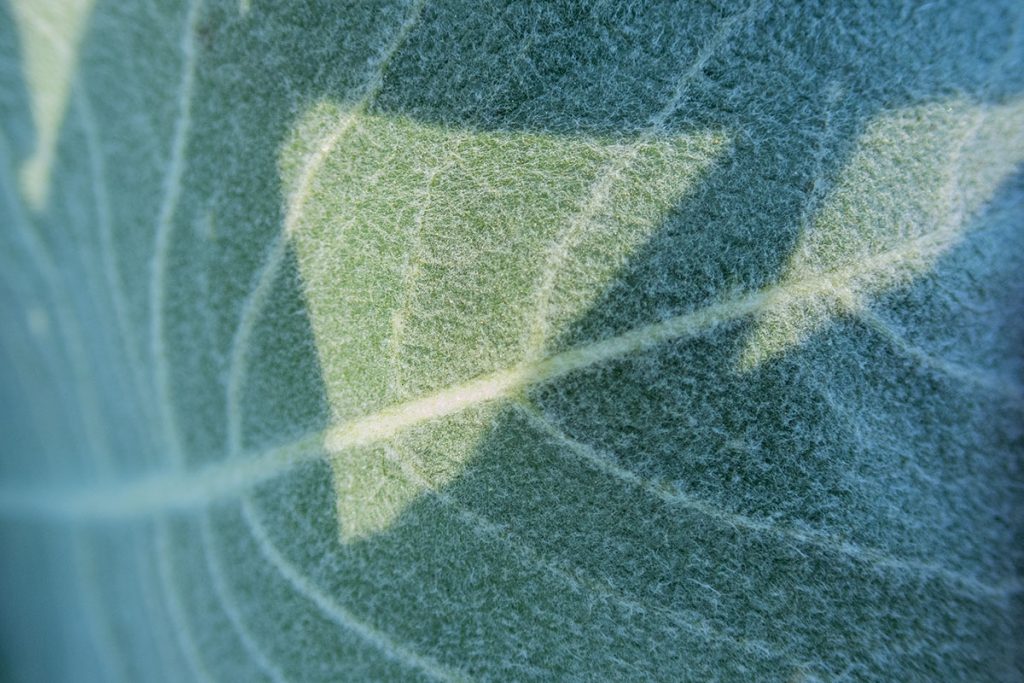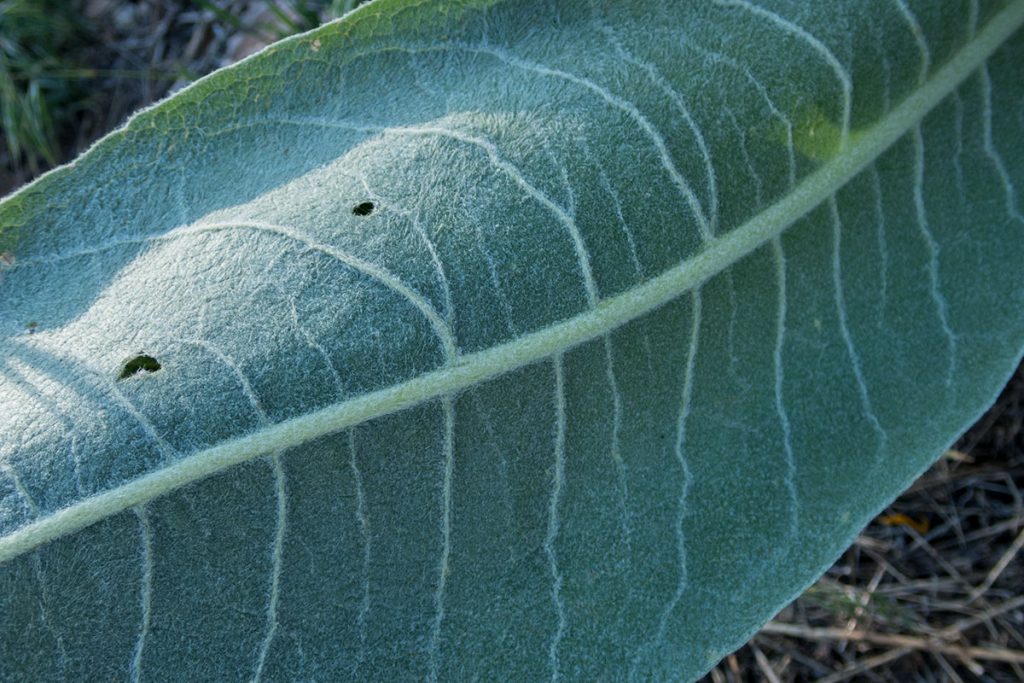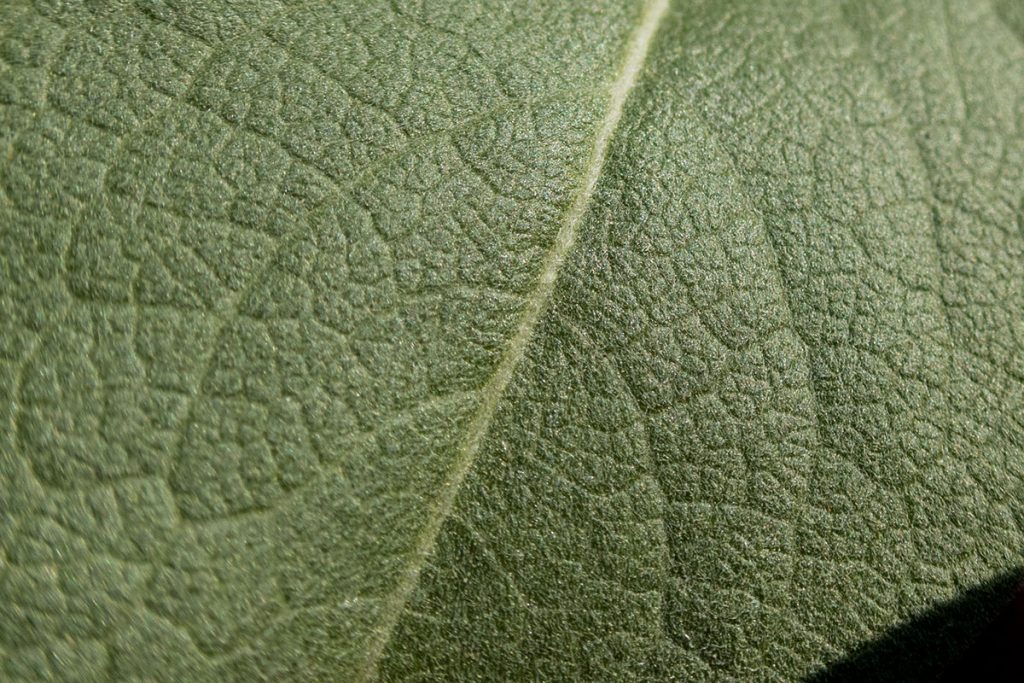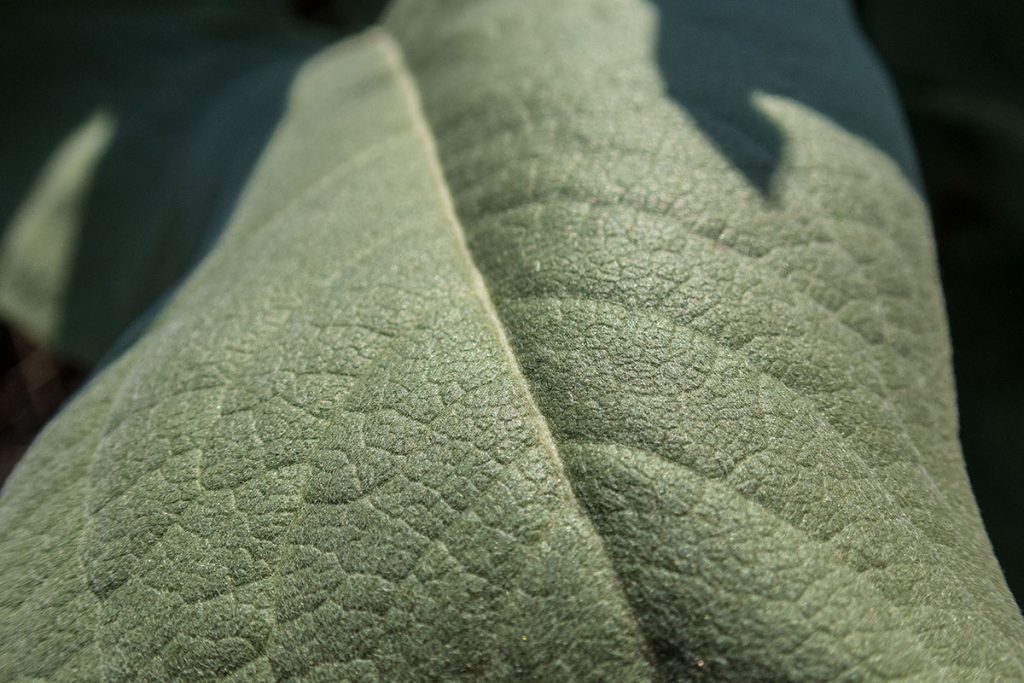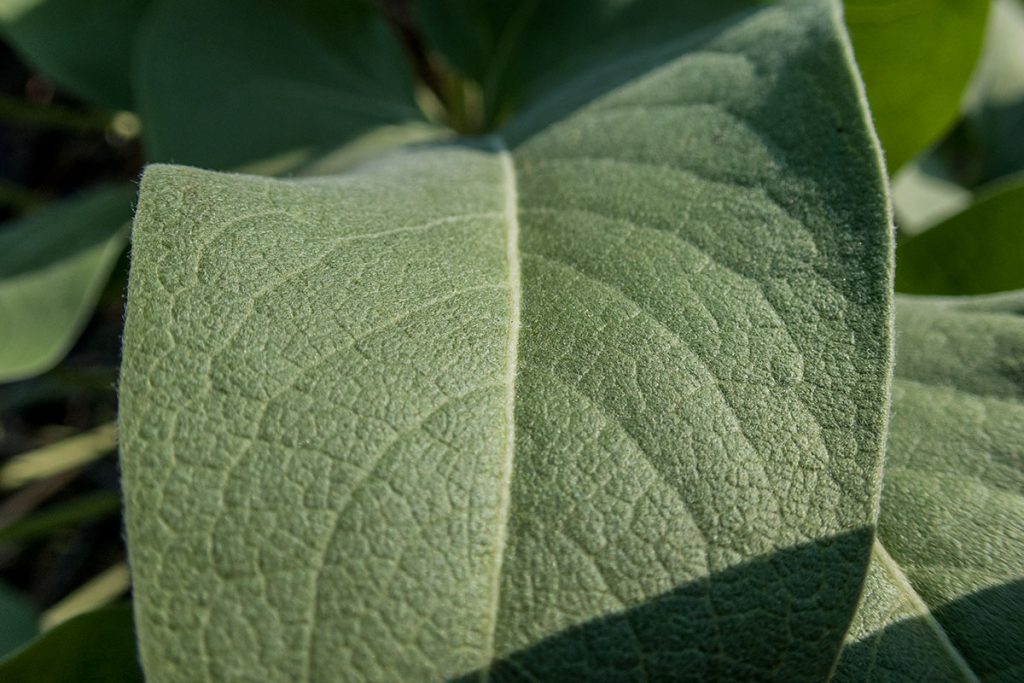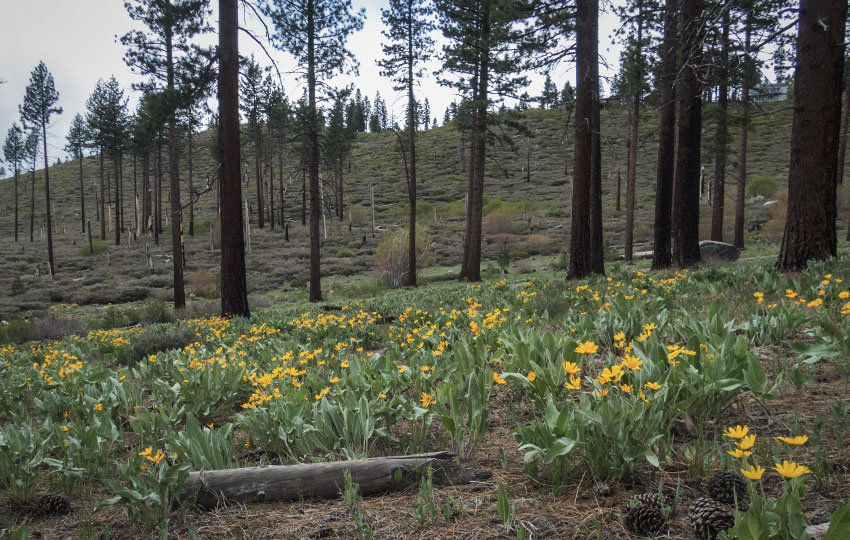
I first met Lake Tahoe’s ubiquitous Woolly Mule’s Ears in 2006. Since that was my first summer living at Lake Tahoe, I was eager to learn about this new home of mine. So I enrolled in a basic mountaineering course at Lake Tahoe Community College. This seemed like a great way in which to gain a better lay of the land, physically and metaphorically.
During the class the instructor pointed to the leaves of a Woolly Mule’s Ears plant. He said, “That’s called mountain money. Remember it well. You won’t find a softer and more durable natural toilet paper anywhere in the Sierra Nevada!”
He was right 🙂
Support Tahoe Trail Guide with a financial contribution via PayPal (single contribution) or Patreon (reoccurring contributions). Your support of Tahoe Trail Guide is very much appreciated!

The problem, however, was that all big yellow wildflowers with big green leaves became Woolly Mule’s Ears from that point forward. That is until I looked closer at them some years later. On a hike with my friend to Freel Peak, I shared that same mountain wisdom about those Charmin-like leaves. But as I pointed toward the leaves in question, I doubted myself. There was something different about them. They weren’t almond-shaped like I remembered. And, they didn’t feel nearly as soft.
This observation caused me to investigate the matter further. So, I took some photos and then consulted wildflower reference books when I returned home. As a result, I learned about the similar-looking Sierra Nevada wildflower called Arrowleaf Balsamroot.
In hindsight, I can totally understand why people mistake Woolly Mule’s Ears (Wyethia mollis) with Arrowleaf Balsamroot (Balsamorhiza sagittata). I did for years, after all! Both species share a similar appearance with their big yellow flowers and big green leaves. And, they tend to bloom at about the same time. To make matters even more challenging, you can often find them growing together in large patches across the Lake Tahoe landscape.
All Big Green Leaves are Not Created Equally
One of the most defining characteristics of both wildflowers are their leaves. I agree that they’re both big and green. However, they each have a unique shape and feel to them.
Leaf Shape
Not surprising, the Woolly Mule’s Ears common name is based on the appearance of its leaves. Essentially, the leaves loosely resemble an actual mule’s ear in size and shape. Now, I personally have very little firsthand knowledge of mules let alone the characteristics of their ears. So I can’t say with any authority that they do, in fact, look like a mule’s ear. Instead, I prefer to describe the leaves as being almond-shaped or oval. Besides, I suspect that most people have more experience with almonds than mules.
Another characteristic of the Woolly Mule’s Ears leaf shape is that it tapers abruptly at the midvein where it connects to the petiole. This midvein is the vein that runs down the middle of the leaf. The petiole is the stalk connecting the leaf itself to the plant’s main stem.
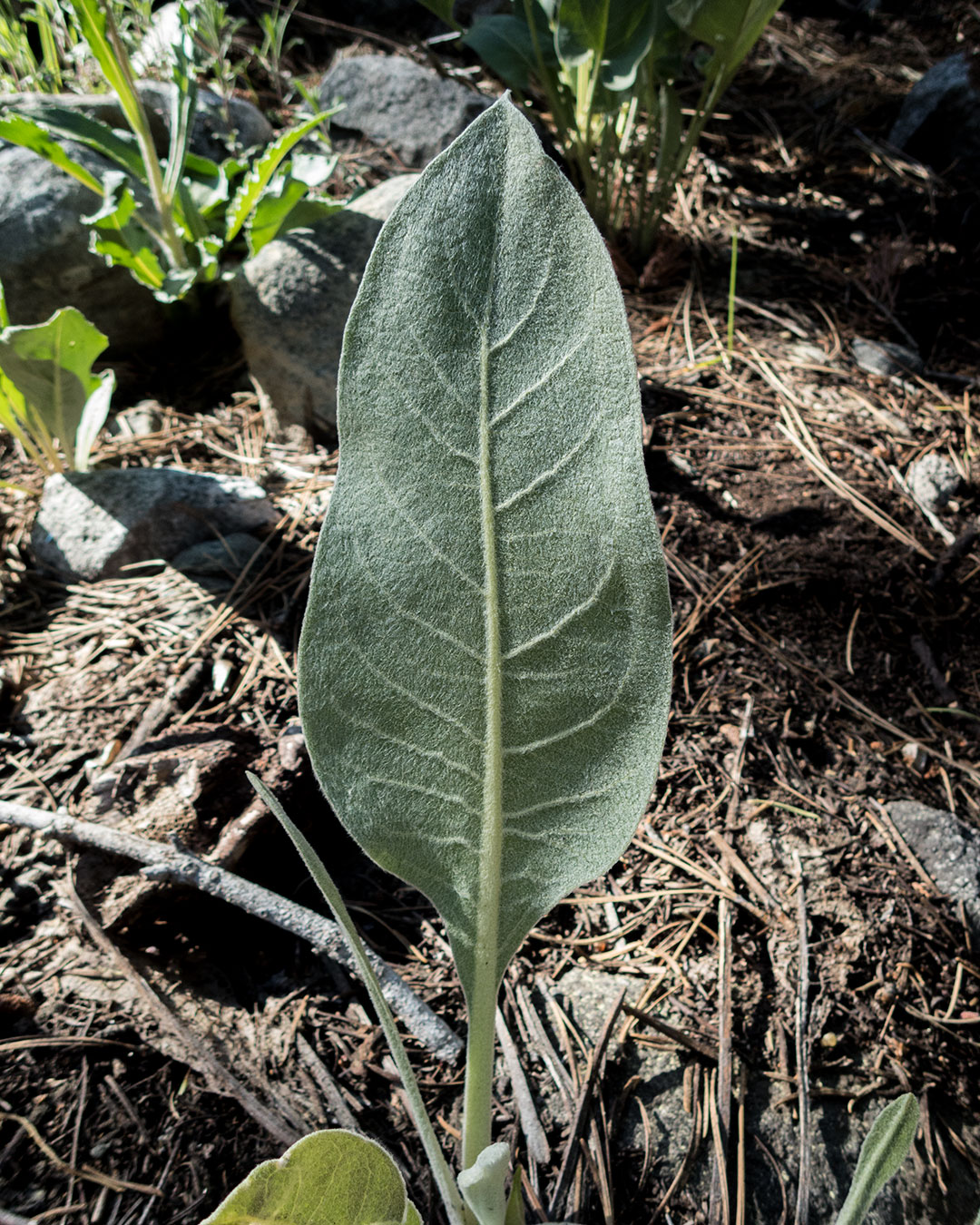
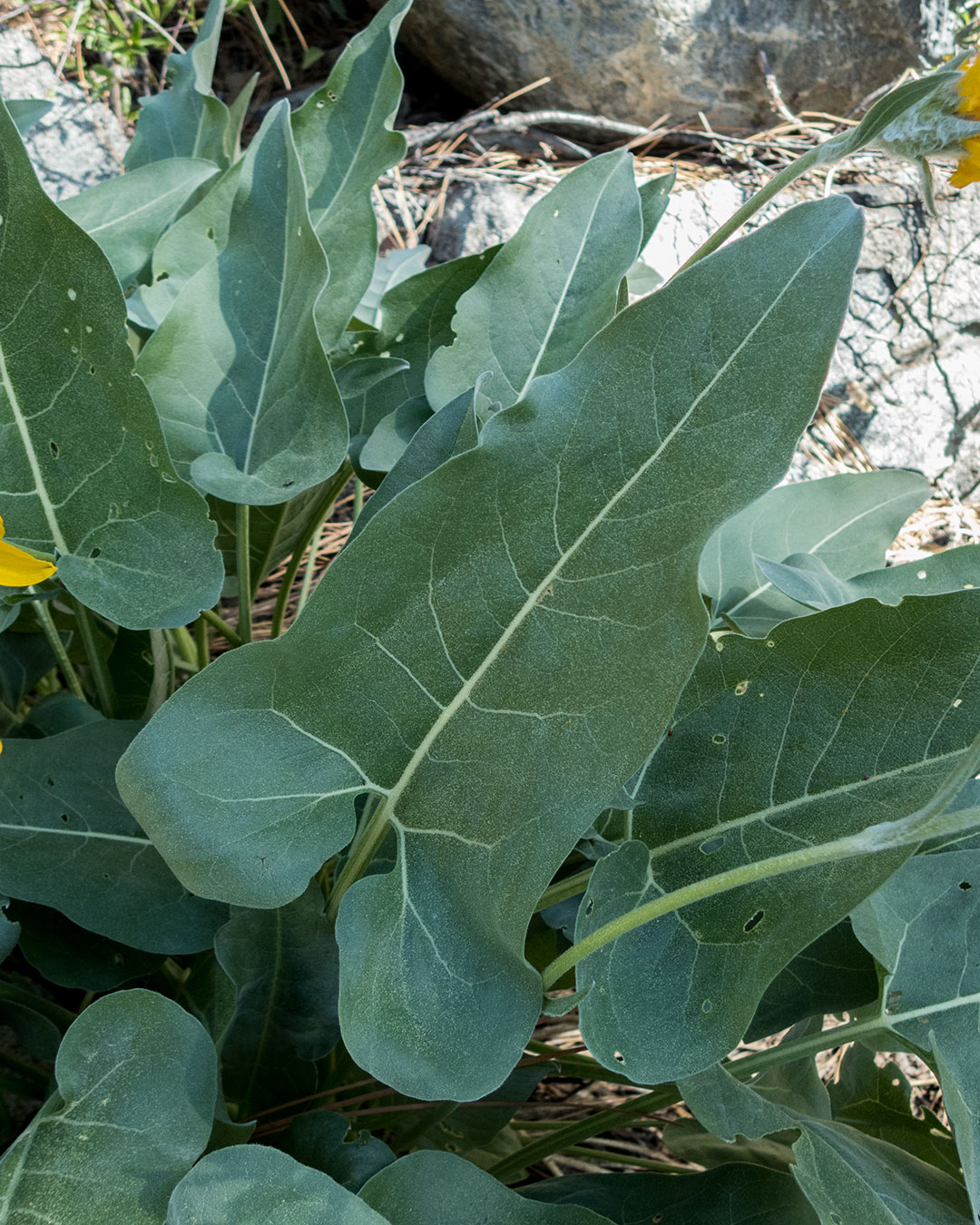
Arrowleaf Balsamroot also derives its common name from the shape of its leaves. In this case, its leaves look like arrowheads. They are triangular-shaped with a very pointy tip. I believe that most people have a general idea about the shape of an arrowhead. So, I do describe the leaves as such.
Additionally, each leaf of the Arrowleaf Balsamroot has two distinct lobes where it meets the petiole.
All of that said, I’ve seen plenty of arrowheads before. And, many of them actually resemble the shape of a Woolly Mule’s Ear leaf. So describing something can be a funny thing, right? As they say, the devil is in the details.
One other detail to consider about each species’ leaves is their orientation. The leaves of Woolly Mule’s Ears primarily grow upright. On the other hand, Arrowleaf Balsamroot leaves tend to fall over or droop down.
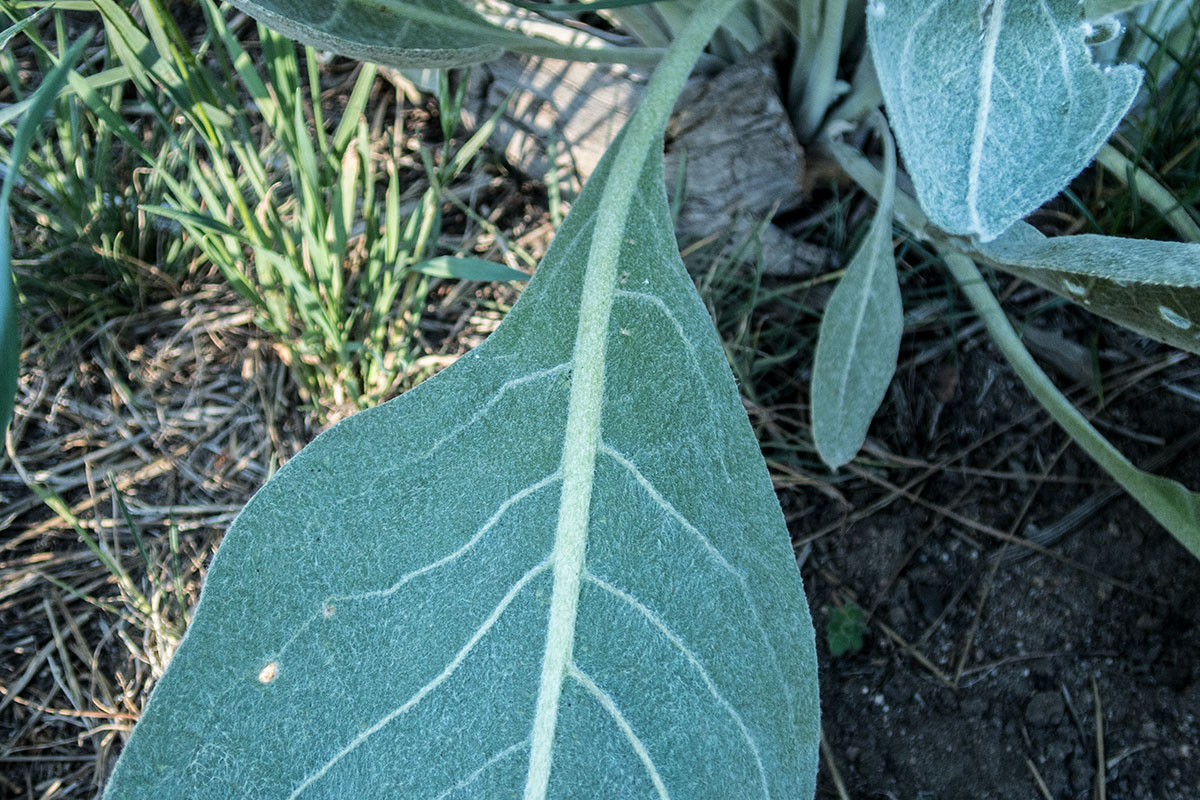
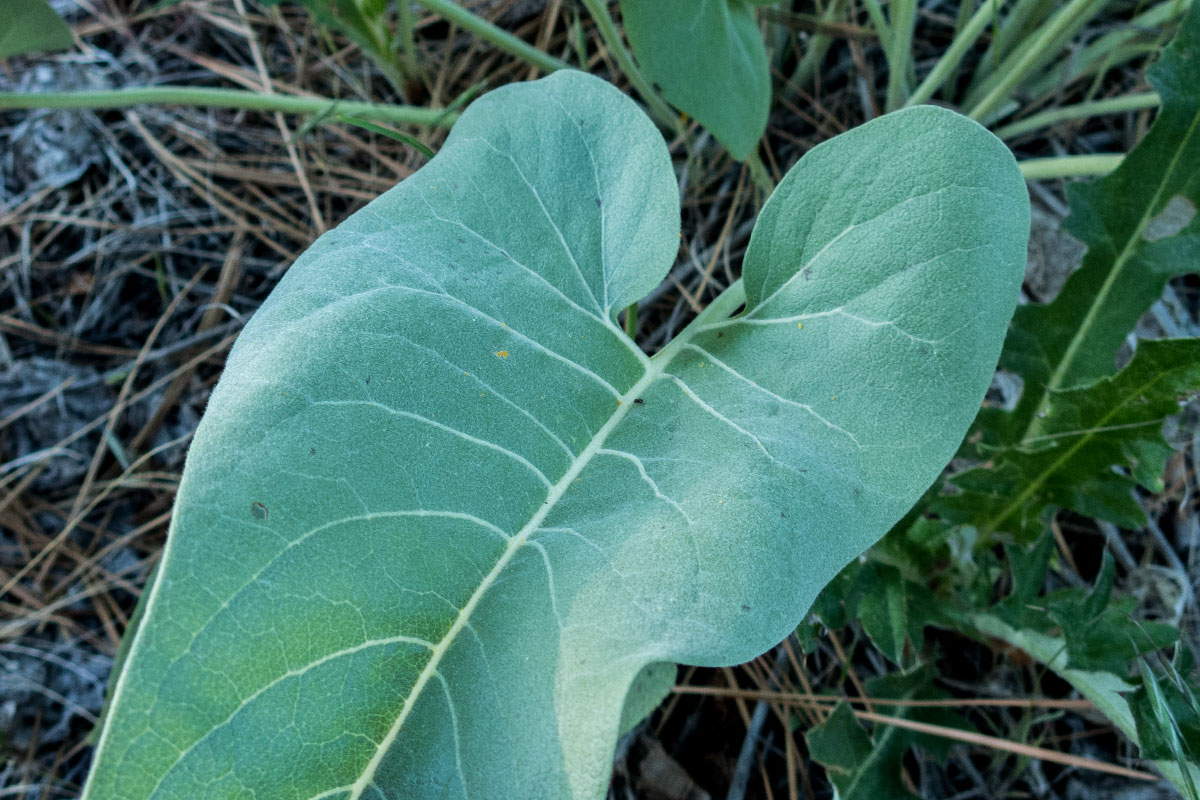
Feel
Woolly Mule’s Ears leaves have a matte-looking finish due to their hairy nature. This is also why they’re soft to the touch, much like a favorite childhood blanket. On the other hand, Arrowleaf Balsamroot leaves lean toward being leather-like and shiny. They loosely remind me of bat wings the way they flop around on a windy day.
The soft versus leathery tactile quality of their leaves is one of the distinct differences between both species. In fact, Woolly Mule’s Ears can arguably be called the only true “mountain money.” This is because its leaves are so soft.
In contrast, the slick veneer of Arrowleaf Balsamroot leaves just winds up being an unsatisfactory knockoff. That is, for those times when nature calls.
Flowers
Both species have relatively large flower heads. At least as far as Sierra Nevada wildflowers go!
The flowers of Woolly Mule’s Ears can grow up to 3 inches in diameter. Arrowleaf Balsamroot flowers can be similar in size as their flower heads range between 2-4 inches.
Both species also feature ray and disc flowers. Ray flowers are the larger and more obvious petals that create the outer ring of the flower head. To me, they look like rays shining outward from the sun. Disc flowers, on the other hand, form the central portion of the flower head. For example, imagine that the flower head is an eyeball. With that image in mind, the disc flowers would essentially be its pupil.
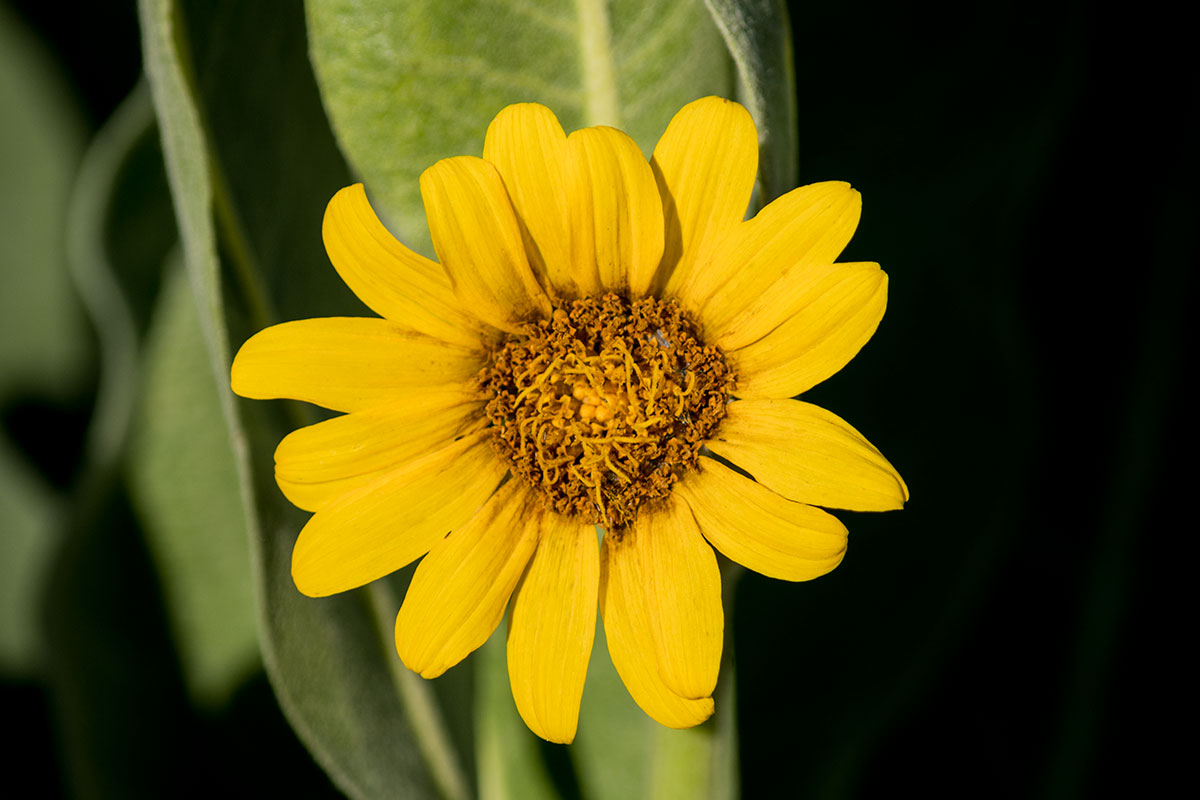
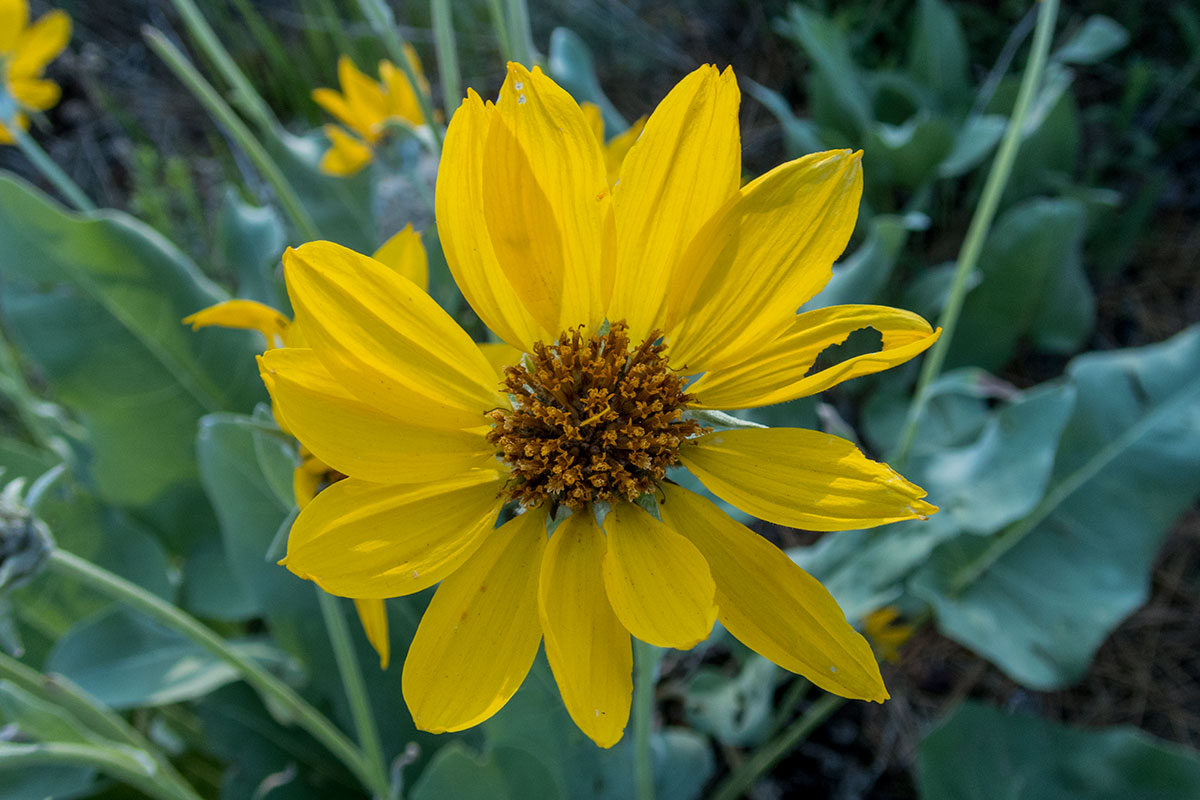
Since both flowers look similar, it’s helpful to keep the following rule of thumb in mind when identifying each plant.
That is to say that the flowers of Woolly Mule’s Ears typically reach about the same height as its leaves.
In contrast, Arrowleaf Balsamroot flowers are usually taller than their leaves.
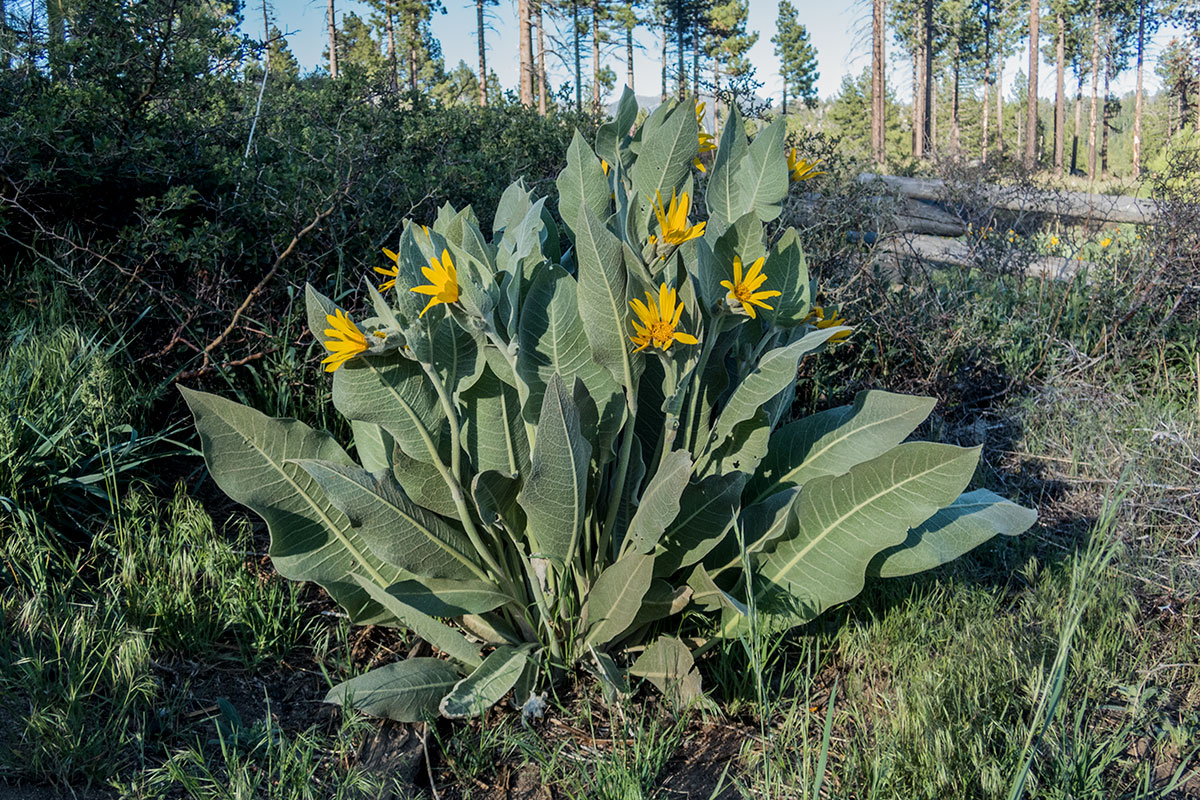
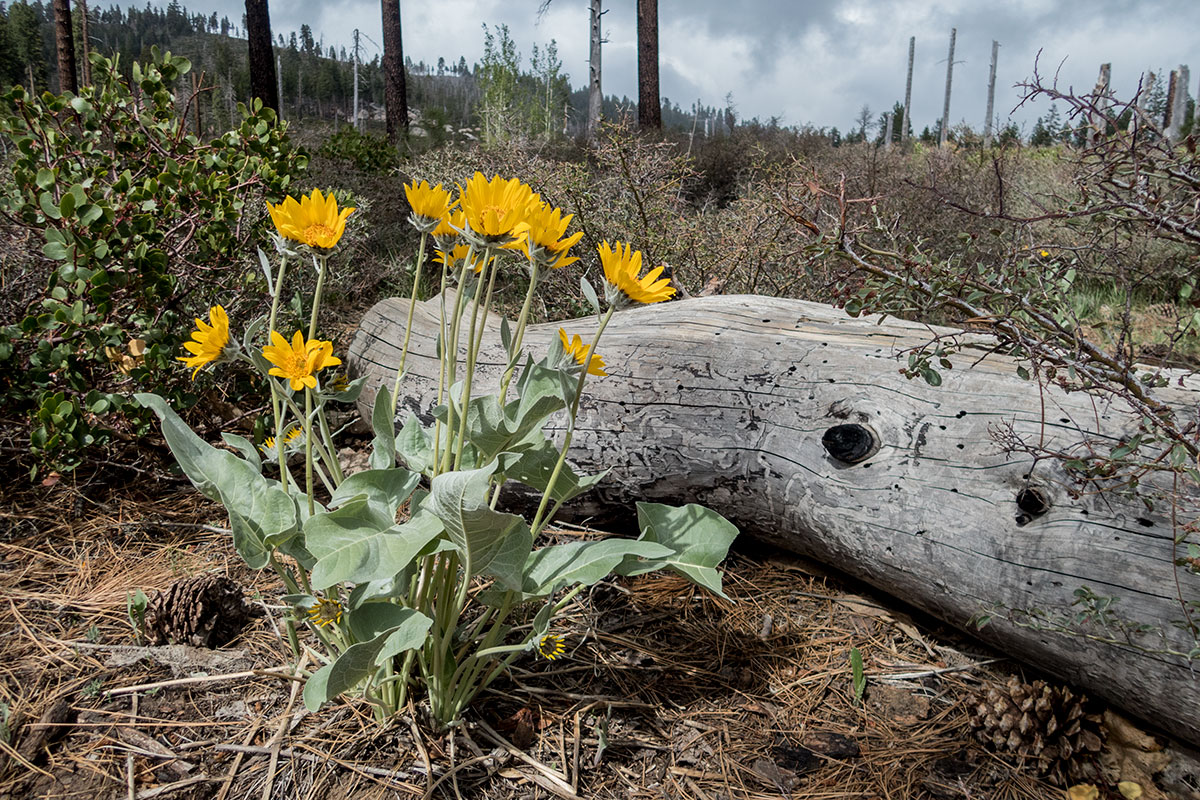
I have to be honest, though. I’ve never actually held an Arrowleaf Balsamroot leaf upright to compare heights between the leaves and flowers. So, I couldn’t say with 100% certainty whether or not the flowers actually grow taller or if it’s just an optical illusion created by the fact that its leaves droop down. But I believe the flowers do, in fact, grow above the leaves.
Let me know if you’ve performed this experiment (and its results) in the comment section below 🙂
Bloom Season
Woolly Mule’s Ears and Arrowleaf Balsamroot start to bloom in May. This, of course, depends on Lake Tahoe’s snowpack from the previous winter. For example, my last day of my cross-country skiing for the 2018-19 season was June 13th. So, I can say with absolute certainty that no wildflowers were blooming at Carson Pass on that day! That said, I’m sure there were some of both species blooming much closer to Lake Tahoe (lower elevation).
Bloom times are also dependent upon on the specific aspect of terrain in which you’re travelling. For example, south and west faces are constantly bathed in sun. So, the snow at these locations melts faster yielding earlier blooms. In contrast, northern and eastern aspects of terrain are often protected from direct sunlight so they hold snow longer. Therefore, wildflowers usually bloom a little later at these locations. Then, you have to consider elevation as I briefly mentioned above. Basically, snow melts faster at lower elevations while it persists at higher elevations.
Arrowleaf Balsamroot declines by July during a “normal” year. Woolly Mule’s Ears, on the other hand, enjoys another month of life by remaining until August.
All of that said, I’ve found that Arrowleaf Balsamroot often blooms a couple of weeks earlier than Woolly Mule’s Ears. It’s for this reason that I believe it’s overlooked and mistakenly identified as Woolly Mule’s Ears.
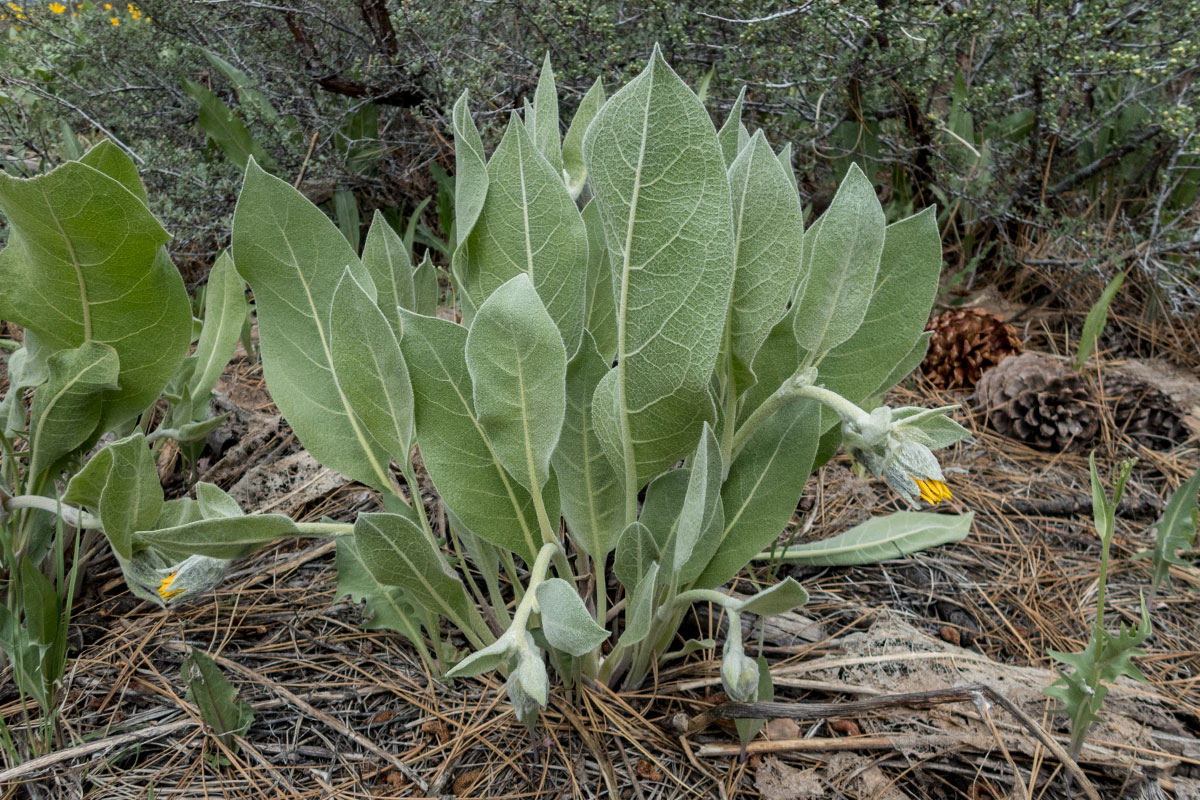
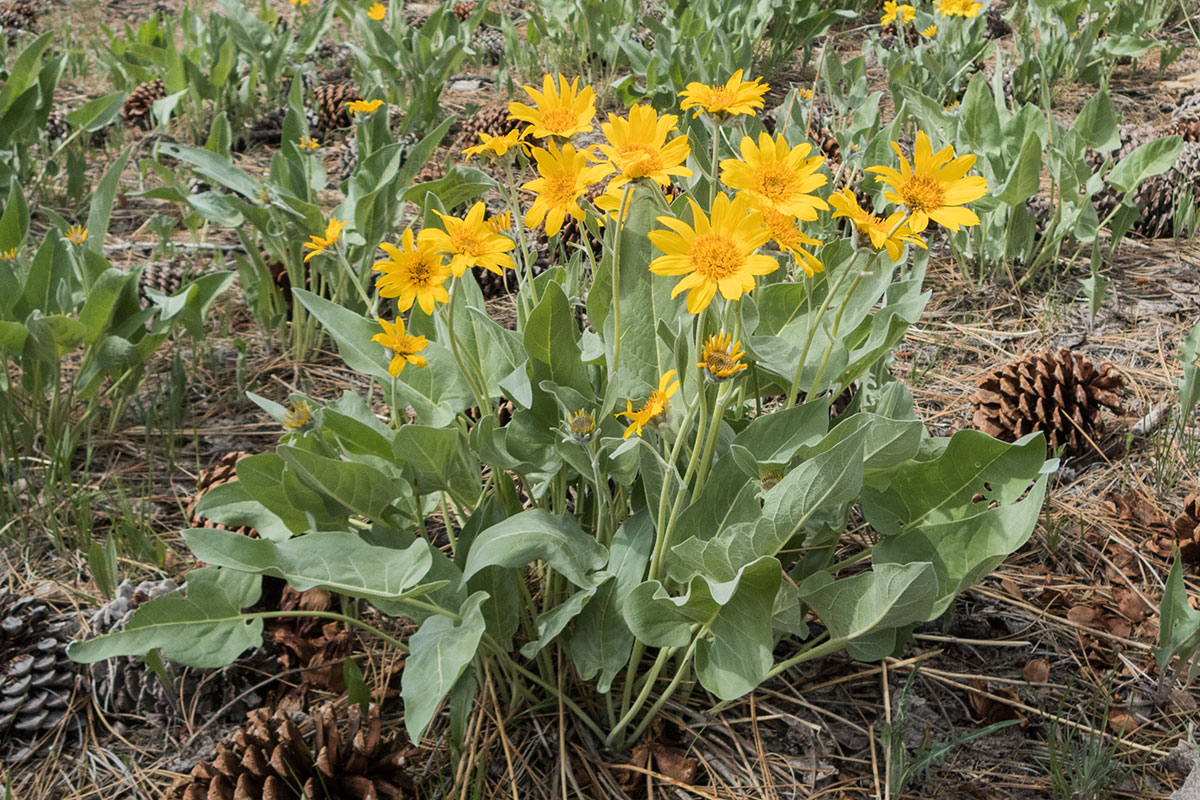
Hear me out…
Many locals and visitors to Lake Tahoe want to start hiking by April and May. The ski resorts are closed, so it’s time to hit the trails. The problem, though, is that even after a less-than-stellar winter there can still be a lot of snow in the higher elevations. Like I mentioned, those northern aspects hold snow longer. Therefore, many of Tahoe’s quintessential hiking trails are just not very accessible without extra effort and safety precautions.
As a result, the snowpack seems to have a psychological effect on people. When they see snow still on the mountains they become metaphorically blinded to the idea that early season wildflowers are beginning to emerge elsewhere. After seeing and/or encountering that snow they call it a day and resolve to return two weeks later, for example, to take another crack at hiking Mount Tallac (or wherever). During this waiting period, those early season wildflowers either come and go or come and stay.
Arrowleaf Balsamroot fits into the latter category. But when people start to actually notice it, Woolly Mule’s Ears has begun to catch up. It doesn’t even matter if its flowers haven’t begun to bloom yet. The leaves are fully developed and obvious. So you end up with these fields of the two species intermingling and basically looking like one homogenous group.
The next thing you know, everyone’s like … hey, look at that huge patch of Mule’s Ears over there!
I totally agree that this theory is pure speculation. But I’ve experienced it firsthand. And I can’t be the only person who’s felt this way. In fact, that same year that I skied so late into spring (2019) was the first Tahoe Wildflower Big Year in which I participated. Because there was so much snow everywhere I was still in the skiing mindset. So I just couldn’t believe that anything would actually be blooming at that point in the season.
I hate to admit, but prior to that wildflower big year (2019) I usually just assumed that nearly everything bloomed at about the same time. And, that was usually when the snow finally melted. But snow melts at various times at various locations and at various elevations.
So my long-held, grossly oversimplified assumption is clearly not accurate in any way, shape, or form!
Growing Habitat
You can find isolated patches and individual plants of both Woolly Mule’s Ears and Arrowleaf Balsamroot throughout the Lake Tahoe Basin. But generally they prefer locations that feature dry and sandy soils. This could be a rocky slope at a higher elevation near Mount Rose or Barker Pass, for example. Or, you could find them in a lake-level mixed coniferous forest that has little ground cover other than pine needles on decomposing granite.
I have seen both plants growing in grassy meadows where the soil is relatively moist. However, they seem to thrive best in wide open, sunny spaces. To me, they look most impressive when they cover the hillside of a south and west facing slope. Whenever I see these large swaths of wildflowers growing in such a manner, I’m reminded of the Very Large Array of satellites in New Mexico. But instead of listening for radio waves from the furthest reaches of the galaxy or gathering data from black holes, these wildflowers spend their days collecting solar radiation (i.e. sunshine!).
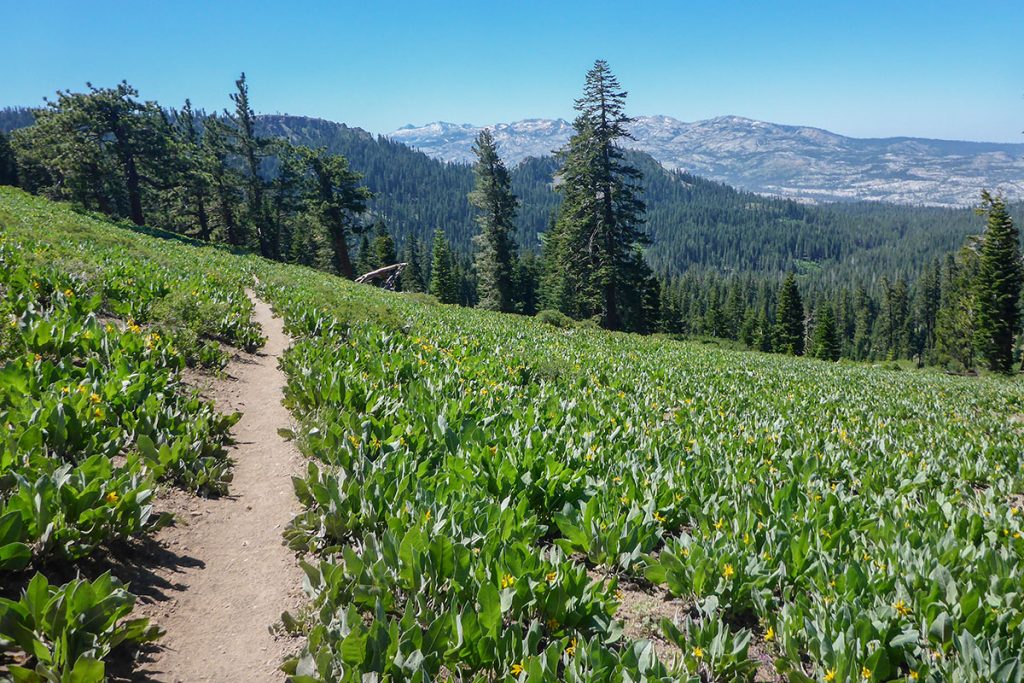
In the context of the Tahoe Basin, the low range of elevational growth for either species is irrelevant. This is because they both grow at “lake level.” As you can probably imagine, lake level is the elevation of Lake Tahoe itself (6,229 feet) and is the lowest point in the basin. But for the sake of completion, Woolly Mule’s Ears starts to grow at 3,000 feet and Arrowleaf Balsamroot at 4,600 feet.
In the uphill direction, Woolly Mule’s Ears can grow to an elevation of 11,200 feet and Arrowleaf Balsamroot to 8,500 feet. Keep in mind that the highest point at Lake Tahoe is Freel Peak, which stands at 10,881 feet. So, Woolly Mule’s Ears has the potential to grow nearly anywhere in the basin. Arrowleaf Balsamroot, on the other hand, tops out at that lower elevation.
To me, this is interesting because knowing the bottom and top end of each plants’ growing range can help with identification. But it can also aid in determining your general elevation if you didn’t have an altimeter, for example.
With that last thought in mind, I challenge you the next time you’re hiking one of the taller peaks at Lake Tahoe monitor where you last you saw Arrowleaf Balsamroot and note its elevation.
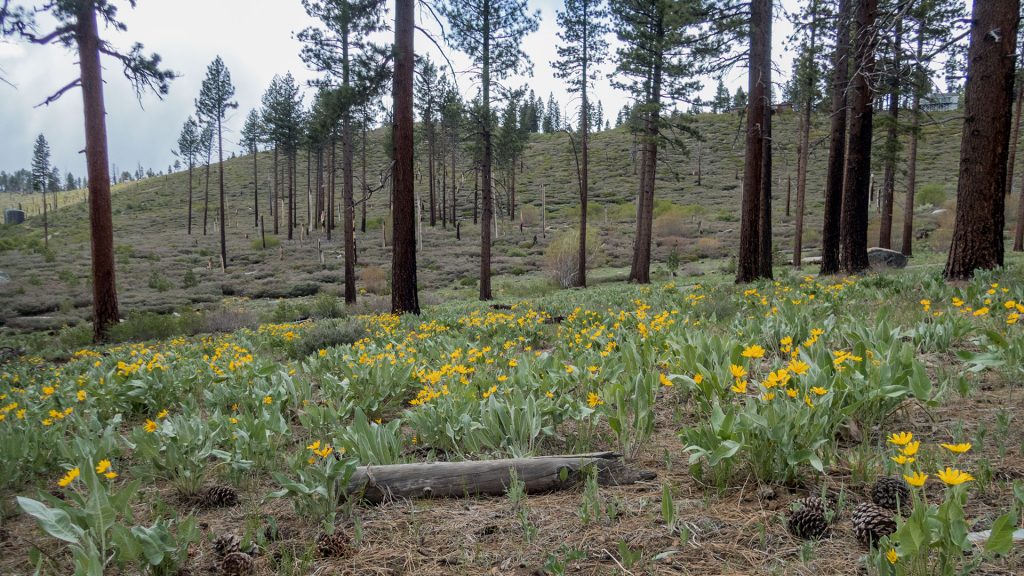
Question of Intention aka Conclusion
So, why is it important to distinguish both species from one another? That is, beyond simply knowing which of its leaves make for better toilet paper? Well, you got me there.
If we’re going down that path I guess the broader and more relevant question to ask is, “Why is learning anything about nature important?”
I write these natural history articles to share with you entertaining and educational material that’ll enhance your outdoor experience. These works won’t transform you into world-famous botanists, for example. Their scope is relatively limited, all things considered. But they do provide a starting point for your own research. It’s my hope that after answering some basic questions about those big yellow wildflowers with the big green leaves, for example, that you’d continue to ask questions.
- Why does it grow here?
- What is its connection to the landscape?
- Is it native or was it introduced to the region by humans (anthropogenic)?
- Or, was it brought here by wildlife?
- How does it benefit wildlife?
- Can it be eaten or consumed by humans?
- And, does it have medicinal properties?
As much as I’d love to be able to answer all of those questions, that would entail writing an entire book. And that’s not really what I’m trying to accomplish here.
Again, let’s just start by taking a closer look at our surroundings the next time we go outside. Because the more we become aware of the flora/fauna around us, the more we become invested in preserving it.
Best Wildflower Hikes of Lake Tahoe
Please note that this is an abridged list of Tahoe wildflower hikes. Since there are countless wildflower hikes at Tahoe, it’s going to take me time to compile them all. In the meantime, here’s a start. Please note that the locations without a link are articles I’ve yet to write.
- Winnemucca Lake
- Frog Lake
- Washoe Meadows State Park
- Cathedral Meadow
- Spooner Lake
- Rabe Meadow
- Meek’s Creek
- Paige Meadows
- Tahoe Meadows
- Watson Lake
- Freel Meadows
Articles About Lake Tahoe Plants and Wildlife
The following Tahoe Trail Guide articles feature information, history, and stories about the various forms of plant and wildlife that you can find at Lake Tahoe.
Lake Tahoe Wildflowers
- Two Major Factors that Determine Peak Bloom Times for Wildflowers at Tahoe
- Tips for Finding Wildflowers at Tahoe
- The Sinister Mustard Flower Rust
- Big Yellow Wildflowers with Big Green Leaves called Woolly Mule’s Ears and Arrowleaf Balsamroot
Trees of the Sierra Nevada
Birds of Lake Tahoe
- The Tree Cleaving Pileated Woodpecker
- How Woodpecker Contribute to Healthy Forests at Lake Tahoe (and other fun facts)
